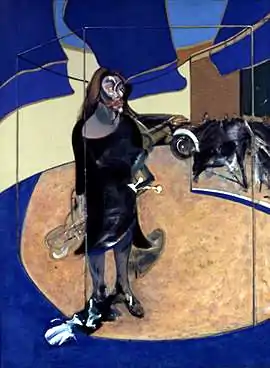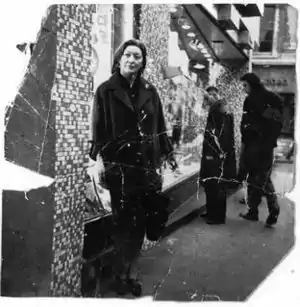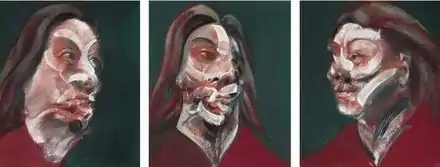Portrait of Isabel Rawsthorne Standing in a Street in Soho
Portrait of Isabel Rawsthorne Standing in a Street in Soho is a 1967 oil on canvas painting by the British figurative artist Francis Bacon, housed in the Alte Nationalgalerie, Berlin. Described by art critic John Russell as one of Bacon's finest works,[1] it depicts Isabel Rawsthorne, the painter, designer and occasional model for artists such as André Derain, Alberto Giacometti and Picasso.


Bacon met her in the late 1940s through Erica Brausen, who was exhibiting both artists in her Hanover Gallery in London. He portrayed Rawsthorne many times, including three large scale canvases and three triptychs in the 1960s, as well as around 15 smaller portraits.[2] She was a great beauty with striking facial features, and was a formidable character. She fascinated Bacon and was perhaps the friend he respected most during the 1960s. According to his biographer Michael Peppiatt, "in her animal exuberance and the resolute sense of her individuality ... she had a magnetism and mobility of expression that captivated Bacon".[3] Although notably gay, in an interview soon after her death in January 1992, Bacon hinted that they had recently had an affair.[2][4]
Description

Bacon's 1960s paintings are characterised by closely modelled heads. By this time he was highly social, and liked to spend long nights with associates such as Lucian Freud (they later fell out, for unexplained reasons), Peter O'Toole, George Melly, Muriel Belcher, John Deakin and Henrietta Moraes. Belcher was a close friend, and the proprietor of the highly selective Colony Room in Dean Street, Soho.
The extant portraits of Belcher are unusual for Bacon who was so preoccupied with figures in rooms, in that it has an outdoor setting. After the 1950s, and apart from his bullfight series, it is one of the few to place the subject outdoors.[5] In addition it is one of his few in which the subject seems aware and engaged with its surroundings. The other portraits that show a similarly outwards looking figure are also of Rawsthorne.[6]
References
Notes
- Russell 1971, p. 125.
- Zweite 2006, p. 148.
- Peppiatt 1996, pp. 204–205.
- His only earlier sexual encounter with a woman was with a prostitute. Bacon claims it was unsuccessful.
- Sylvester 2000, p. 151.
- Farr, Peppiatt & Yard 1999, p. 55.
Sources
- Farr, Dennis; Peppiatt, Michael; Yard, Sally (1999). Francis Bacon: A Retrospective. New York: Harry N. Abrams, Inc. ISBN 978-0-8109-2925-8.CS1 maint: ref=harv (link)
- Peppiatt, Michael (1996). Anatomy of an Enigma. London: Westview Press. ISBN 978-0-8133-3520-9.CS1 maint: ref=harv (link)
- Russell, John (1971). Francis Bacon (World of Art). New York: Norton. ISBN 978-0-500-20169-5.CS1 maint: ref=harv (link)
- Sylvester, David (2000). Looking back at Francis Bacon. London: Thames and Hudson. ISBN 0500019940.CS1 maint: ref=harv (link)
- Zweite, Armin (ed). (2006). The Violence of the Real. London: Thames and Hudson. ISBN 0-500-09335-0.CS1 maint: ref=harv (link)
Further reading
- Davis, Ben. "Bacon Half-Baked". Artnet artnet.com. Retrieved December 28, 2015.